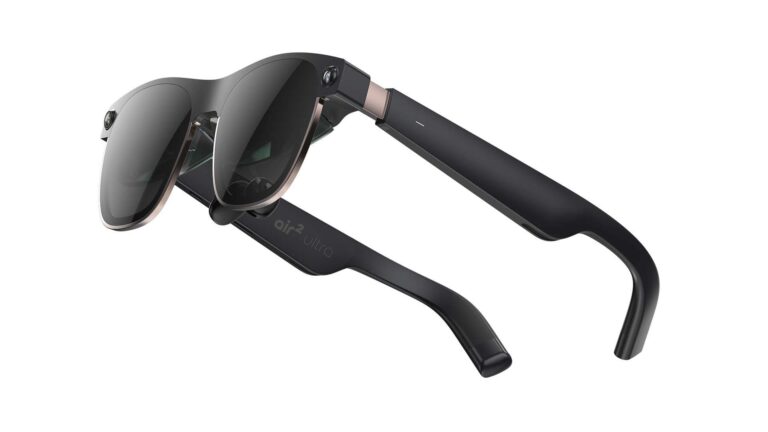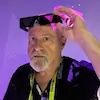
The last six months – including CES – has seen an inflection in new smart glasses. Eschewing the idea that faceworn wearables have to offer Magic-Leap style dimensional graphics or Hololens2-style jack-of-all-trades capabilities, these smart glasses are simpler, focused, and stylistically viable. For example, last week, we examined Solos AirGo 3 and its reliance on AI rather than complex visuals. The surprise-success Ray-Ban Meta Smartglasses carry a similar torch.
Elsewhere in the smart glasses continuum is XReal Air 2, which similarly leans on a focused use case. In this instance, that use case is screen-reflecting smart glasses that simulate for the user a huge high-definition screen seen from ten feet away. Since it launched just ahead of CES, the device has become a category leader with this approach.
The glasses can be paired with mobile phones, PCs, handheld game consoles, and any display that would benefit from an impossibly large 330” screen on the go. Using the Beam accessory, the massive virtual screen can be anchored anywhere in your environment, which is far preferable to having the big screen anchored in the center of your field of view, moving as your head does. The Air2 is $399 and Beam is $119. For those of us who wear glasses, Xreal provides an insert that requires a custom prescription lens. Unsurprisingly, the biggest and brightest is among the most expensive.
The Air2 is light, a mere 72 grams, which makes it the lightest of the screen-reflecting AR glasses. It’s comfortable enough to wear for hours. Its frame, though thicker than traditional eyewear, looks pretty natural, considering it houses dual Sony Micro-LED displays and a sensor to detect user wear. The arms of the glasses are a bit bulky, too, with speakers, USB-C, a power button, and a rocker switch to control brightness. So, while the Air2 looks kinda cool, no one is going to think you are wearing regular glasses. The Air2 has upgraded display technology, with dual Mini-OLED panels from Sony delivering a resolution of 1920 x 1080 per eye. Pixel density meanwhile improves over the device’s predecessor from 3320 ppi to 4032 ppi, resulting in a sharper, clearer image. Honestly, you’d rather have that than more style.
We loved the way the original Air just worked when you plugged it into your Android device. Now Air2 similarly connects to the iPhone 15, ditching the adapters, which are still necessary for older iPhone models. For those, we recommend the Beam, a $119 wireless accessory designed to optimize XReal’s wireless connectivity. This compact, battery-powered device serves as a bridge between the glasses and various input sources, including smartphones, tablets, and computers. Importantly, it allows users to place screens around them, rather than having the projection anchored in the middle of the users’ field of view.
Xreal’s closest competitor among smartphone screen extenders is the Rokid Max AR, and its companion Rokid Station, which is a touch heavier at 75 grams; and Virtue, which was made specifically for use with the Steam Deck.
The Air 2 represents a solid step forward for the pioneering Chinese company. Improvements in design, display quality, and device compatibility mark it as a significant upgrade over its predecessor. While there are areas for improvement, particularly in sound quality and the persistent need for adapters, the Air 2 is a compelling choice for those seeking an enhanced mobile viewing or gaming experience.
 Charlie Fink is the author of the AR-enabled books “Metaverse,” (2017) and “Convergence” (2019). In the early 90s, Fink was EVP & COO of VR pioneer Virtual World Entertainment. He teaches at Chapman University in Orange, CA.
Charlie Fink is the author of the AR-enabled books “Metaverse,” (2017) and “Convergence” (2019). In the early 90s, Fink was EVP & COO of VR pioneer Virtual World Entertainment. He teaches at Chapman University in Orange, CA.

